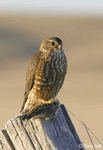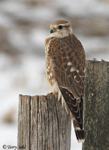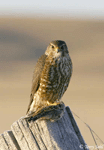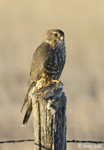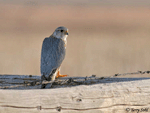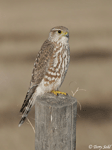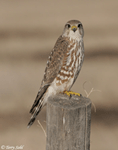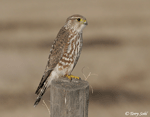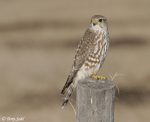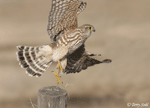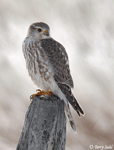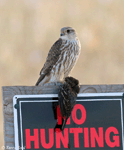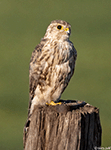Merlin
Falco columbarius
| Length: 12 inches | Wingspan: 25 inches | Seasonality: Winter / All Seasons |
| ID Keys: Dark tail with light-colored bands, heavily streaked underparts. Prairie ("Richardson's") male blue-gray above, female brownish above | ||
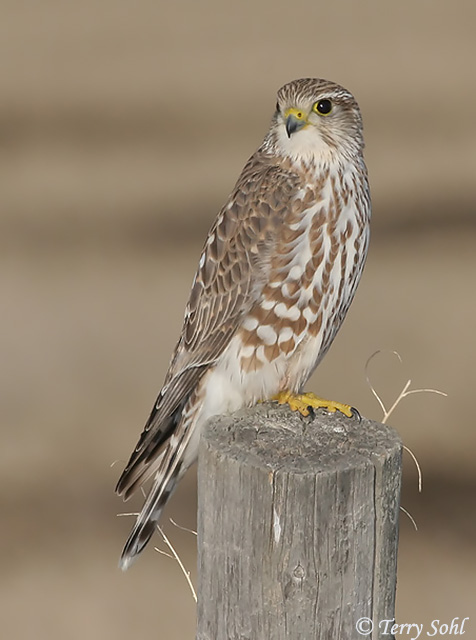 Also known as the"Pigeon Hawk", the Merlin is a small, fast falcon which
is a deadly hunter of its avian cousins, catching small birds in flight. Merlins have become adapted
to living in urban areas and may overwinter in cities, taking advantage of the
steady supply of House Sparrows and Rock
Doves (pigeons) that urban centers provide. They are not only found
throughout much of North America, but in parts of Europe and Asia. In
South Dakota, they are found as a summer breeding bird in select parts
of the far western parts of the state. They disperse much more widely in
winter and could be found anywhere in the state.
Also known as the"Pigeon Hawk", the Merlin is a small, fast falcon which
is a deadly hunter of its avian cousins, catching small birds in flight. Merlins have become adapted
to living in urban areas and may overwinter in cities, taking advantage of the
steady supply of House Sparrows and Rock
Doves (pigeons) that urban centers provide. They are not only found
throughout much of North America, but in parts of Europe and Asia. In
South Dakota, they are found as a summer breeding bird in select parts
of the far western parts of the state. They disperse much more widely in
winter and could be found anywhere in the state.
Habitat:
Merlins prefers mixed habitat of trees and adjacent open spaces for breeding. They may winter in nearly any habitat, as well as there's a strong supply of the bird species upon which they prefer to prey.
Diet:
Merlins mostly feed on small birds, but sometimes they will also take small mammals, insects, and reptiles. They will feed on whatever variety of birds may be found near their nesting sites during the summer breeding season, but in migration and winter months, they may specialize on one or a few species. I've often seen them following mixed flocks of Horned Larks, Lapland Longspurs, or Snow Buntings during the winter months in South Dakota. They'll take birds as small as a sparrow or as large as a pigeon.
Behavior:
Primarily hunts from a perch, flying out to capture prey when it is sighted. Much of their prey is taken in flight, including birds that flush upon a Merlin's approach. Merlins will also fly low over the ground in order to surprise prey.
Nesting:
May and June in South Dakota. Breeding is proceeded by ritualistic courtship flights, with both the male and female performing acrobatic flights in front of the other, or with each other. Merlins don't built their own nest, instead re-using the nests of hawks, crows, magpies, or other birds. They perform no modification to the existing nest site, nor are they likely to come back and consistently use the same nest year after year. The female lays between 2 and 6 eggs, and does the majority of the incubation. The male will bring the female food during the incubation period, often presenting it with a bow and a flared tail. Incubation lasts about four weeks, and when the young hatch, the routine doesn't change much at first, with the female staying with the young while the male hunts and delivers food to both his mate and young. The female may start to make forays from the nest as the chicks near fledging. They usually fledge from the nest after about 30-35 days from hatching.
Song:
Rapid shrill ki-ki-ki-ki, given by both males and females, primarily during courtship and in interactions with their own kind, but also sometimes as an alarm call. Both males and females have a similar sounding call, but females is typically higher pitched, while males is lower pitched and a bit harsher. They also have a short, sharp single 'kik' call that seems to serve as a contact call.
- Click here to hear the ki-ki-ki-ki call of a Merlin1
- Click here to hear another typical call of a Merlin2
- Click here to hear the calls of a female near a nest, and then a responding juvenile Merlin3
Migration:
Merlins summer in Canada and the northern U.S. Rockies, and winter through the western half of the country and along the East Coast.
Interactive eBird Map:
Click here to access an interactive eBird map of Merlin sightings
Similar Species:
Merlins could potentially be confused with multiple other falcon species, all of which are found in South Dakota.
- American Kestrel - The other "small" falcon in South Dakota, American Kestrels are actually smaller than a Merlin, although the size difference is close enough that it's difficult to judge a bird in the field on size alone. Adult males are easy to differentiate, as American Kestrel males have a rich reddish back and crown, a bluish tone on the wings and head, and a very strong facial pattern with bold, black stripes. Females are more difficult as female American Kestrels lack the bright colors of the male. However, they still have the two bold dark facial stripes that differentiate them from Merlins. Female American Kestrels also have a horizontal barring pattern on their back, while Merlins have more of a solid color on the back.
- Prairie Falcon - Prairie Falcons share some of the same seasonal patterns that Merlins follow in South Dakota, with some breeding in the far western edge of the state in the summer, and then spreading out across most of the state in the winter. They are a larger bird than a Merlin, with a size difference that's pronounced enough that size can sometimes be used to judge which species it is. In terms of plumage, Prairie Falcons have a stronger facial pattern than Merlins, with an obvious black "mustache". They also have less dark markings on their light underside than does a Merlin.
- Peregrine Falcon - Peregrine Falcons are mostly migrants in South Dakota, but can cross paths with Merlins in the state. As with Prairie Falcons, they are a substantially larger bird than a Merlin, and size alone can sometimes be used to differentiate them. Peregrine Falcons have a much stronger pattern on the head, with adult birds having a "hooded" appearance and a bold dark mark trailing down the face that's even more pronounced than the mustache of a Prairie Falcon.
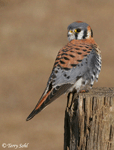 |
 |
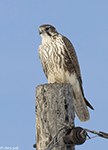 |
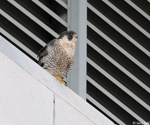 |
| American Kestrel (male) | American Kestrel (female) | Prairie Falcon | Peregrine Falcon |
Conservation Status:
Like with other raptors, the use of the pesticide DDT in the middle-part of the 20th century caused a rapid decline in Merlin numbers. However, numbers started to recover once DDT was banned. Systematic surveys in the North American part of the Merlin's range have shown substantial increases in overall populations in recent decades. Trends are uncertain or mixed in the Old World part of their range. Overall, Merlins are found across a very broad geographic area, are relatively common in parts of that range, and have strong overall numbers. The IUCN considers the Merlin to be a species of "Least Concern".
Further Information:
Photo Information:
March 1st, 2008 -- Near Presho -- Terry Sohl
Additional Photos:
Click on the image chips or text links below for additional, higher-resolution Merlin photos.
Audio File Credits:
- 1Simon Elliott. Recorded in Northumberland, England on July 5th, 1987. Original recording and information available from xeno-canto.
- 2Thijs Fijen. Recorded in Kazakhstan on June 5th, 2013. Original recording and information available from xeno-canto.
- 3Andrew Harrop. Recorded in the Shetland Islands of Scotland on July 2nd, 2020. Original recording and information available from xeno-canto.
| Click on the map below for a higher-resolution view |
 |
| South Dakota Status: Uncommon migrant and winter visitor. Rare summer breeder in the extreme western edge of the state. |
Additional Merlin Photos
Click for a higher-resolution version of these photos
